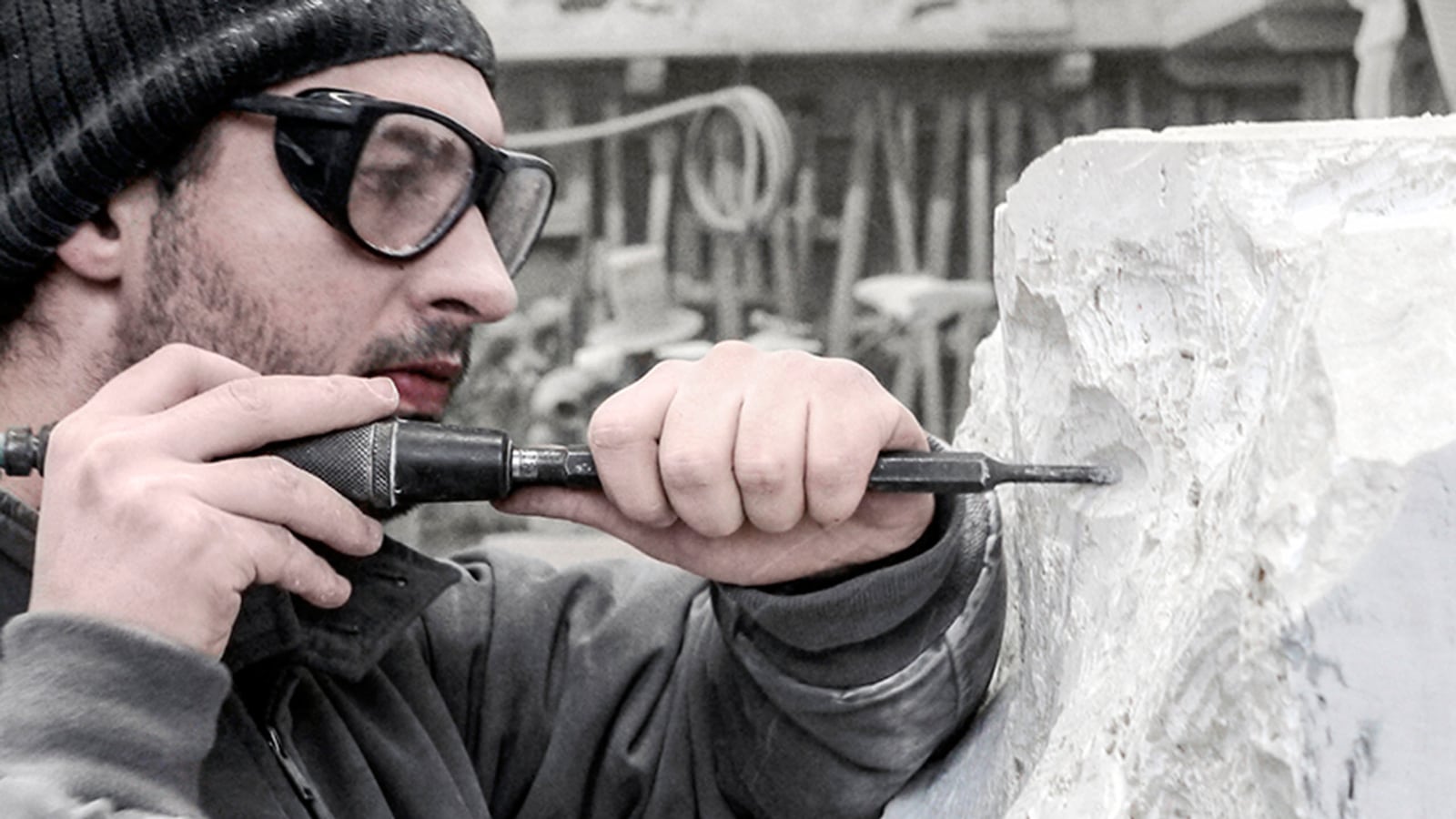Henryk Hetflaisz is a photographer, who—in taking pictures of sculptors in their studios—became fascinated with how they actually sculpt. He discovered very few artists today inhabit the kind of “autobiographical” studios we associate with greats like Barbara Hepworth or Constantin Brâncuși, where design and dusty practice happened in messy, kinetic tandem.

Today, says Hetflaisz, some sculptors work exclusively on computer screens, employing Computer Assisted Design; some work at their desk, shaping small sheets of paper or steel to create models or maquettes; others make maquettes from wood, or wet clay. “More conceptual artists have no work space at all, simply imagining ideas for a work, which they communicate with words.”
So where, wondered Hetflaisz, was the large public work of artists such as Damien Hirst, Fernand Botero, or Marc Quinn, created in marble or bronze? Where was it actually carved or cast?
The secret, he discovered, lay in a small Tuscan hill town called Pietrasanta, and so he traveled there, as dozens of eminent artists, from Michelangelo to Henry Moore, have done over the centuries.
Here, just 30 miles from Pisa, in the foothills of the marble mountains of Carrara, were hidden the kind of studios he had been hoping to photograph.
Hetflaisz discovered a wonderland, or as he beautifully puts it, “hiving teams of industry: marble yards, filled with dozens of passionate artisans, covered in marble dust as they use power drills and small chisels to create the monumental works of the world’s most famous artists; molten hot bronze foundries, where asbestos-clad artisans make wax molds of works before casting them in bronze.”
The results of his expedition can be seen in Hetflaisz’s first New York show of photography, Homo Faber (Working Man), at the Italian Cultural Institute, opening December 4.
Artist Jean (Hans) Arp has worked with Pietrasanta artisans, or artegiani, as they are called, so have Jacques Lipchitz, Joan Miró, Marino Marini. In more recent times Fernando Botero, Helaine Blumenfeld, Giò Pomodoro, Isamu Nogichi, and Igor Mitoraj are just a few of the artists who rely on their skills.

Hetflaisz, a 34-year-old Polish-born photographic artist, working in London, has had one-man shows in London’s Surface Gallery, the Museo dei Bozzetti, and at Gallery 27 on Cork Street. He has worked with the Parisian photography museum, the Jeu de Paume, and the UK’s Fitzwilliam Museum, and has had his work published in many newspapers and magazines.
In addition to art photography, Hetflaisz delights in shooting other artists, and spent many weeks photographing in the forty studios of Pietrasanta, where skills are passed on from generation to generation.
“These, I discovered, were the real studios of many of the world’s greatest sculptors,” he said. “This is where their small models come to life, in stone or metal, often many stories high. It seemed to me that the artisans were the unsung heroes of the art world and through taking their portraits I hope to celebrate them.”
Most of the artegiani are men and most are Italian, but Hetflaisz also met several women, like a young artisan named Evalina, who he photographed at work on one of Damien Hirst’s angels. “There were young artisans in their early twenties and some older artisans still at work in their early seventies, passing on their craft to the next generation. I was lucky to meet Sergio at Studio Sem, who I photographed working on a head by [Norwegian sculptor] Knut Steen—and sadly both artist and artisan have died since the photo was taken.”
The marble studios, says Hetflaisz, are nestled around the edge of the medieval town, each occupying a large open space. Some have locked storage for models and tools, but mostly they are exposed to the elements, with corrugated clear plastic sheets to offer shelter from occasional rain and matting to offer occasional shade from the hot Tuscan sun. Most employ between just five to 10 artisans.

“Sometimes, the artisans work in pairs, but mostly in the marble studios, they work on their own, on one stage of a sculpture’s evolution,” Hetflaisz says. “From roughing out, to undercutting, to polishing, there are many stages involved in scaling up a small model into large finished stone work.”
The bronze foundries also have large outdoor areas, but most of the work takes place inside, in the sweltering heat, near the furnace. There are fans, but Hetflaisz never once saw an air-conditioning unit—and temperatures get up to 100 degrees.
Here too, the artisans work, mostly singly, on one part of the process at a time, from creating wax models, to pouring the bronzes, to welding the different pieces together and producing the final patina that gives the work its color.
“There is no better place to see this process than in the wonderful short film by Silvano Cattai that follows the creation, by many different artisans, of sculptor Helaine Blumenfeld’s monumental bronze work, Tempesta,” says Hetflaisz.
Even today, many artisans are self-taught, learning on the job, at the hand of great master craftsmen, who in turn have learned from their forefathers. Some, indeed, have fathers or uncles who have passed down their skills. “Few, as yet, have mothers or aunts who are old enough to pass on their trade, as female artegiani have only been accepted over the past decade,” the photographer says.
However, today, many of the artisans also come via more traditional routes, such as art colleges and even technical schools.

Of course, one of the major challenges is keeping the next generation interested. Some teenagers do still follow in their ancestor’s footsteps, but most, of course, are tempted away.
“There is an integrity to the skill and craftsmanship of these artisans, but it does not chime with the celebrity-fuelled, materialistic world of Italy in the 21st century,” says Hetflaisz, “where, like young people everywhere, kids want to be rich and famous—more like the artists whose work the artisans slave over, than like the artisans themselves, who are neither highly paid nor hugely recognized. They work anonymously and there is nobility in what they do. But it is not glamorous. It is not sexy. It is an ego-free zone.”
Hetflaisz’s time in Pietrasanta had the “sense of being in a surrealist dream,” as he puts it. “You will see an old man patinating the underbelly of a giant (Fernand Botero) horse, or a beautiful young woman, wearing only a paper mask to protect her from the dust as she carves feathers into a (Damien Hirst) angel that would later sell for more than £800,000 (about $1.26m).”
Hetflaisz photographed “an ancient carver, so covered in dust that he looked more like a marble statue than the sculpture he was working on. There are tiny bronze elephants next to gigantic bronze toes and whole bronze graveyards of cast-off babies’ heads. At Studio Stagetti, I shot a man with more picks and axes than I have ever seen outside an arctic expedition. To me the artegiani seem like sorcerers, not just because they’re brandishing flames or spouting clouds of smoke, but because they appear to have produced creatures, animals or humanoid, of gigantic proportions. There is real magic, real alchemy in what they do.”
That may be true, but this sterling work, this craft, is surely an indictment of the artist who claims authorship or ownership of the work, when others, the artisans, have created it.

“I know that many people are scandalized by the idea that a Tracey Emin isn’t made entirely by Tracey Emin or that a Botero wasn’t crafted by Botero’s own hand,” concedes Hetflaisz. “But successful artists since Michelangelo have always had studios of artisans who copied, crafted, enlarged and mass-produced. This isn’t a new idea—and it is an essential part of the production of large-scale work.”
As a photographer, he is lucky he says: with the help of technology, he is able to be in sole command of the entire artistic process. “But producing a ten-ton sculpture in marble, 20 feet high? That involves teamwork.
Some of the artisans I photographed are also artists in their own right. For them, even if it isn’t free artistic expression, working on other artists’ work is a good way of training in the craft of art, while they get paid.”
One such example, Hetflaisz notes, is Salvatore Anselmo, a talented sculptor who assists Helaine Blumenfeld and recently showed his own large work in Leicester, or Julia Vance who was an artisan and is now a sculptor. Szymon Oltarzewski is a Polish-born artisan who is also a sculptor in his own right. “Other artisans see purity and integrity in their craft and have no dream of becoming recognized as the author of their own work.”
Yet for all artisans, there is an art in their craft, says Hetflaisz. “To do the job well requires a true eye, an extraordinary attention to detail, an ability to translate an idea from one material (usually plaster) into another and of course, a mastery of scale—work looks very different when it is 100 times the size and so many artistic decisions need to be made along the way. When the artist themselves is often continents away, those artistic decisions are made by the artisan. ‘Shall I leave it rough here? Shall I add volume there?’”
The relationship between artist and artisan is therefore very symbiotic, says Hetflaisz. “Each needs the other. Sometimes, in the heat and dust of Pietrasanta, romantic relationships are even forged between artists and artisans.”
None of the artisans Hetflaisz spent time with were resentful of the artists whose visions they spend their days interpreting. “They seemed content to be the silent shapers of other people’s vision. Is there more respect for those artists who have also mastered their craft, for those artists who understand the material and who are able to carve the work themselves? Of course there is. But even those artists who just fax through a drawing of a work which the artisans must then translate into 3D, even these conceptual artists are respected as the paymasters they inevitably are.”
When Hetflaisz saw one artisan, Sergio, working on what looked like a small, miserable model for Knut Steen, he wondered how he could transform it into something complex and layered. Sergio told him: “If there isn’t greatness in the model, I can never make it into a great work of art.”
Is the artisan’s craft a dying one, or will there will always be artisans?
“The laser-wielding robot is a real threat,” Hetflaisz says. “These machines can do much of the heavy lifting and carving that in the past meant the artisans of Pietrasanta seldom worked past 60. The robots can slice through stone and rough out vast blocks of stone while the artisans are sleeping. But when one takes into account all of the artistic decisions, which must be made every day by the human eye, it feels as though, although their duties may change, the artisan will never be replaced.”
Homo Faber is showing as part of the Michelangelo and Versilia exhibition at New York’s Italian Cultural Institute, 686 Park Avenue, from December 4 until January 4.





